Caring for tulips in a vase is simple, and with the right techniques, these vibrant blooms can brighten your home for an extended period. At CARS.EDU.VN, we understand the importance of maintaining beauty in all aspects of life, including enjoying fresh flowers. Discover the secrets to tulip care, including optimal water conditions, stem trimming methods, and vase selection advice. Enhance your floral arrangements and prolong the life of your tulips with our expert advice.
1. A Brief History of Tulips
Tulips boast a captivating history, marked by periods of immense value and admiration. Originating in the Ottoman Empire, these flowers made their way to Europe in the 16th century, quickly becoming a symbol of wealth and status. During the Dutch Golden Age, a phenomenon known as “Tulip Mania” saw the price of tulip bulbs skyrocket, with some rare varieties trading for more than houses. This speculative bubble eventually burst, but tulips have retained their allure as a symbol of spring and beauty. According to the Royal Horticultural Society, tulips are one of the most popular spring-flowering bulbs, enjoyed for their diverse colors and forms.
2. Where to Purchase Tulips
Acquiring tulips is an effortless task, thanks to their widespread availability.
- Local Supermarkets: Most grocery stores offer a selection of tulips, usually at reasonable prices.
- Local Flower Farms: Visiting local flower farms can give you access to a greater assortment and fresher cut flowers, supporting local business owners.
- Online Retailers: Many online retailers sell tulips, often in larger quantities or unique varieties. This is ideal if you’re looking for specific types like Dutch, parrot, or fringe tulips.
3. Selecting the Best Tulips
Choosing the right tulips is essential for ensuring a long-lasting display.
- Bud Condition: Select tulips with closed buds where the flower’s color is visible, a sign they’re ready to bloom.
- Stem Quality: Make sure the stems are firm and upright, not limp or bent.
- Leaf Condition: Check that the leaves are crisp and green, without any yellowing or damage.
- Stem Base: Inspect the cut ends to make sure they look freshly cut and not dried out or split.
4. Conditioning Your Tulips
When you bring your tulips home, conditioning them properly is crucial to extend their freshness and vitality. Conditioning involves rehydrating and preparing the tulips to maximize their water uptake and overall health.
4.1. Trim the Stems Properly
To prepare your tulips, begin by trimming the stems.
- Use a sharp knife or floral scissors to cut the stems at a 45-degree angle.
- Cutting at an angle helps the tulips absorb water more efficiently.
- Remove any leaves that will fall below the waterline in your vase to prevent bacterial growth.
4.2. Rehydrate the Tulips
Rehydrating the tulips thoroughly after cutting the stems can significantly extend their vase life.
- Place the tulips in a bucket filled with cool, clean water, ensuring the water reaches up to the flower heads.
- Allow the tulips to soak in the water for at least 2 hours or overnight. This rehydration process helps restore moisture lost during transportation and storage.
5. Choosing the Right Vase
Selecting the proper vase is essential for both aesthetics and the longevity of your tulips. The vase should provide adequate support for the flowers while complementing their natural beauty.
5.1. Vase Height and Shape
Consider the height and shape of the vase to ensure it suits the tulips.
- Choose a vase that is approximately half to two-thirds the height of the tulips. This proportion helps support the flowers without overwhelming them.
- The vase opening should be wide enough to accommodate the bunch of tulips without overcrowding. Overcrowding can restrict airflow and lead to premature wilting.
- Taller vases are suitable for longer-stemmed tulips, while shorter vases work well for smaller arrangements or tulips with shorter stems.
5.2. Vase Cleanliness
Maintaining a clean vase is vital for preventing bacterial growth, which can shorten the lifespan of your tulips.
- Wash the vase thoroughly with warm, soapy water before each use.
- Rinse the vase completely to remove any soap residue.
- Dry the vase with a clean cloth to prevent water spots and ensure it is free of contaminants.
6. Water and Hydration Tips
Tulips are known for being thirsty flowers, so providing them with the right amount of water and maintaining its quality is crucial for their health and appearance.
6.1. Water Temperature
The water temperature can affect how well tulips hydrate.
- Use cool water to fill the vase. Cool water helps slow down the blooming process and keeps the tulips fresher for longer.
- Avoid using warm or hot water, as it can accelerate the tulip’s growth and shorten its lifespan.
6.2. Water Quality and Changing Frequency
The quality of the water and how often it’s changed can significantly impact the longevity of your tulips.
- Change the water in the vase every day or every other day to keep it fresh and free of bacteria.
- Each time you change the water, rinse the vase to remove any buildup.
- Recut the stems at a 45-degree angle when you change the water to help the tulips absorb water more effectively.
7. Arranging Tulips in a Vase
While arranging tulips might seem straightforward, there are techniques to enhance their natural beauty and create an eye-catching display.
7.1. Simple Arrangement Techniques
Tulips have a natural elegance, and a simple arrangement can often be the most effective.
- Gather the tulips in your hand, ensuring the stems are roughly the same length.
- Gently place the tulips in the vase, allowing them to spread out naturally.
- Rotate the vase as you arrange the tulips to ensure they are evenly distributed.
- Fan out any tulips that seem crowded to give each flower space to shine.
7.2. Embracing Natural Movement
One of the unique characteristics of tulips is their tendency to bend and move towards light, creating a dynamic and evolving arrangement.
- Allow the tulips to follow their natural inclination to bend and sway. This movement adds character and charm to the arrangement.
- Avoid trying to force the tulips into rigid positions, as this can damage the stems and shorten their lifespan.
- Embrace the changes in the arrangement as the tulips grow and move over time.
8. Understanding Tulip Behavior
Tulips are unique in that they continue to grow even after being cut and placed in a vase. Understanding this behavior can help you better care for them and appreciate their dynamic nature.
8.1. Growth and Movement
Tulips can grow an inch or more in the vase, and they tend to bend towards the light.
- This growth is due to a plant hormone that causes the stems to elongate.
- To keep the arrangement balanced, rotate the vase regularly to ensure the tulips grow evenly.
- If the tulips bend excessively, you can gently rotate the vase to encourage them to straighten up.
8.2. Dealing with Drooping
Drooping is a natural part of the tulip life cycle, but there are ways to minimize it.
- Ensure the tulips are properly hydrated by changing the water regularly and recutting the stems.
- Keep the tulips in a cool location, away from direct sunlight and heat.
- Use a vase that provides adequate support for the stems.
- If drooping becomes excessive, you can try wrapping the tulips tightly in newspaper and placing them in water overnight to help them regain firmness.
9. Other Tips for Prolonging Tulip Life
In addition to the basic care steps, there are several other tricks you can use to extend the life of your tulips.
9.1. Environmental Factors
The environment in which you place your tulips can significantly affect their longevity.
- Keep tulips away from direct sunlight, which can cause them to wilt and fade quickly.
- Avoid placing tulips near sources of heat, such as radiators or heating vents.
- Keep tulips away from fruits like apples and bananas, which release ethylene gas that can accelerate their aging.
9.2. Additional Remedies
There are several popular home remedies for keeping tulips fresh, though their effectiveness can vary.
- Penny in the Vase: Some people add a penny to the vase, as the copper is believed to act as a fungicide.
- Aspirin: Adding a crushed aspirin to the water is thought to help keep the water clean and inhibit bacterial growth.
- Flower Food: If your tulips come with a packet of flower food, use it according to the instructions. Flower food typically contains nutrients and antibacterial agents that can help prolong the life of your flowers.
10. Understanding the Symbolism of Tulips
Tulips are not only beautiful but also rich in symbolism, making them a meaningful addition to any setting. The meaning of tulips can vary based on their color, adding layers of significance to your floral arrangements. Here’s a breakdown of what different tulip colors represent:
| Color | Symbolism |
|---|---|
| Red | Red tulips are often associated with perfect love, making them a romantic choice for expressing deep affection and passion. They symbolize strong emotions and are ideal for anniversaries, Valentine’s Day, or any occasion where you want to convey love. |
| Pink | Pink tulips represent caring, attachment, and good wishes. They are a gentle and affectionate option suitable for friends and family. Pink tulips can be given to show appreciation, congratulations, or to express sympathy and support. |
| Yellow | Historically, yellow tulips symbolized hopeless love, but their meaning has evolved to represent cheerful thoughts and sunshine. They are now more commonly associated with joy, happiness, and friendship. Yellow tulips are perfect for brightening someone’s day, celebrating achievements, or simply adding a touch of positivity to a room. |
| White | White tulips symbolize purity, forgiveness, and respect. They are often used in situations where you want to offer an apology or convey a sense of peace and reconciliation. White tulips are also appropriate for sympathy arrangements, weddings, and other events where purity and new beginnings are celebrated. |
| Purple | Purple tulips are associated with royalty and admiration. They can represent elegance, sophistication, and high regard. Purple tulips are a thoughtful gift for someone you admire or respect, or for occasions that call for a touch of luxury and grandeur. They are often used in settings that aim to evoke a sense of regality and beauty. |
| Orange | Orange tulips symbolize energy, enthusiasm, and warmth. They are associated with happiness and can represent a strong connection between two people. Orange tulips are great for celebrating achievements, expressing excitement, or bringing a vibrant and energetic feel to any space. They are often given to show support and encouragement. |
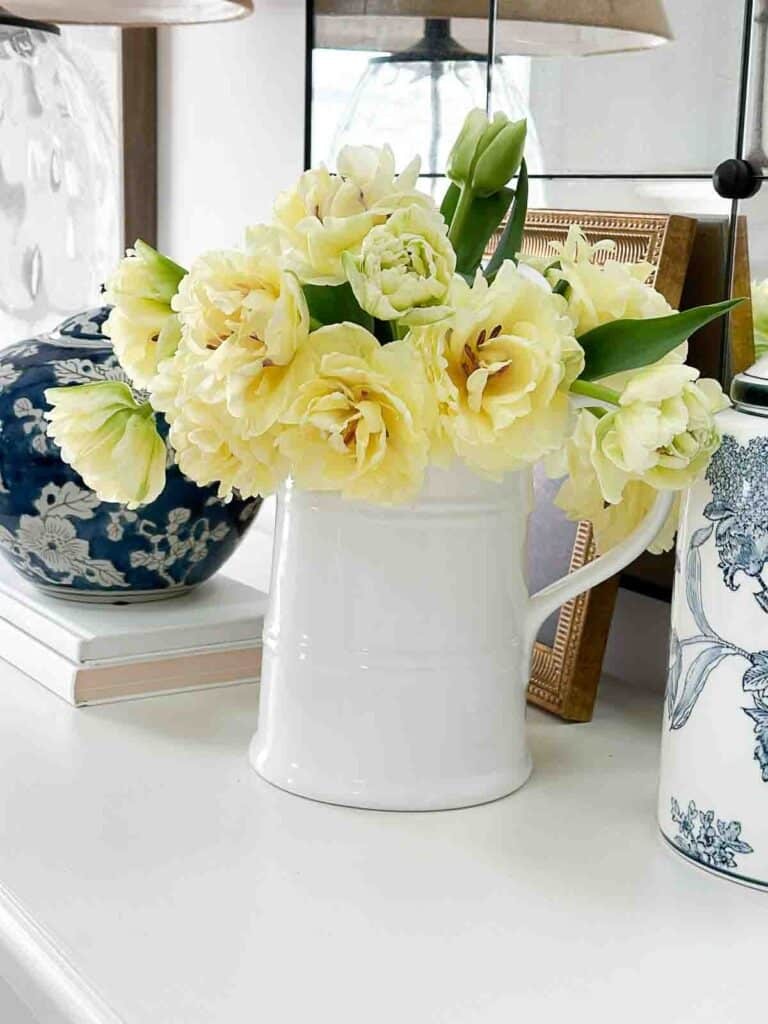
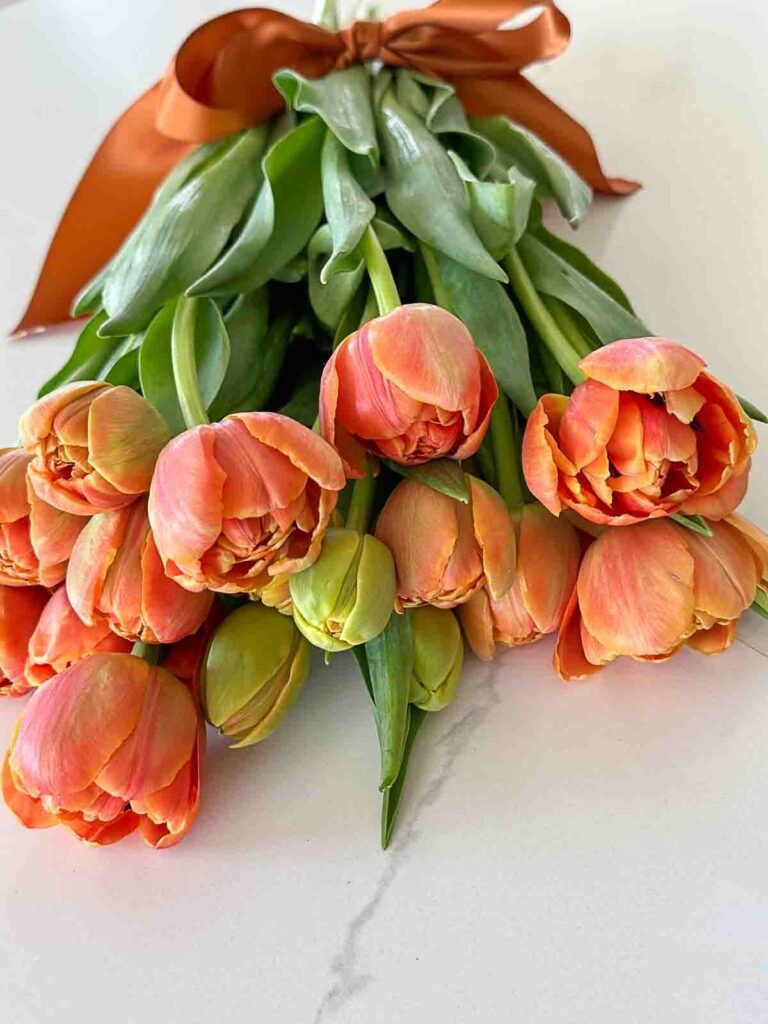

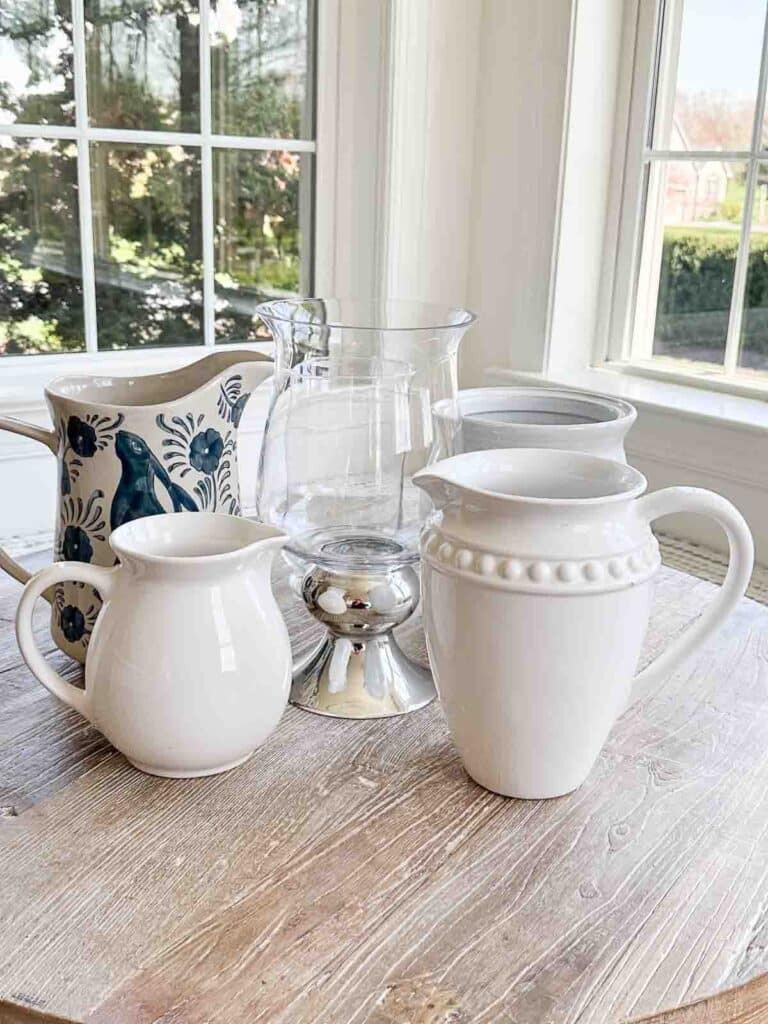
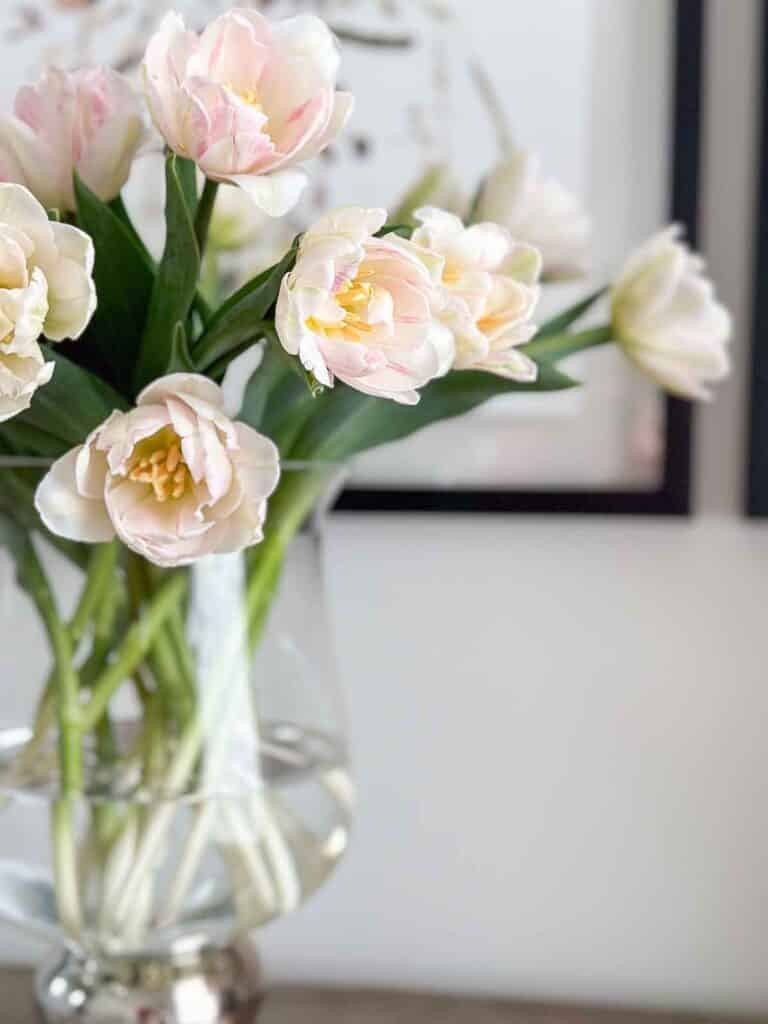
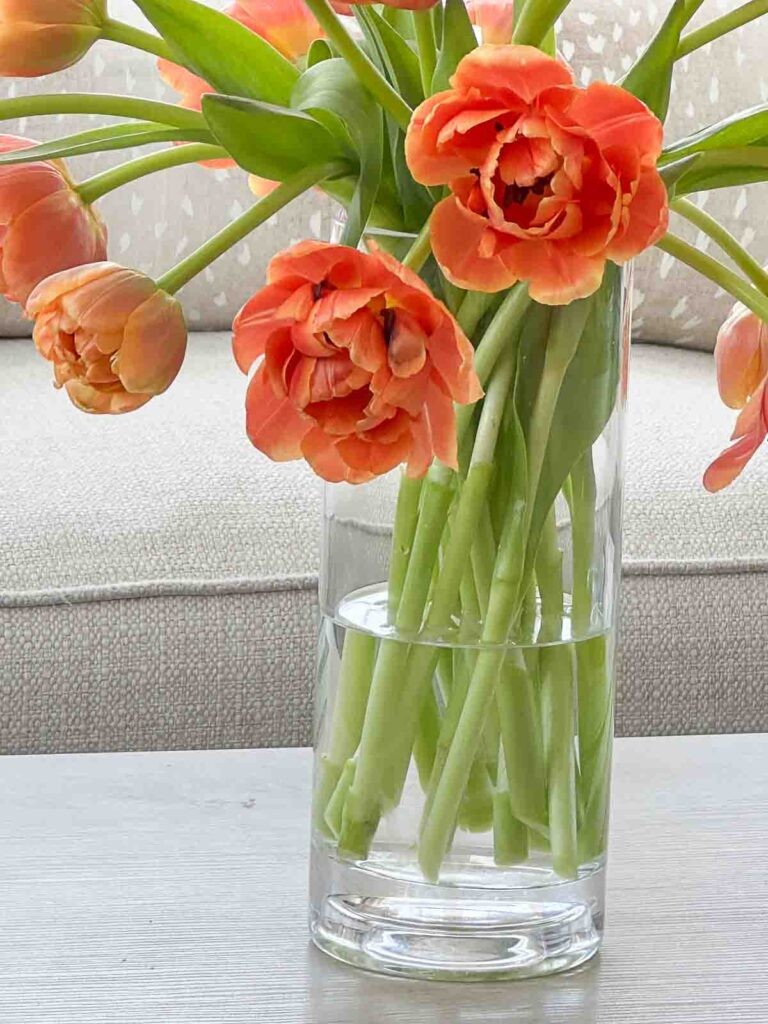

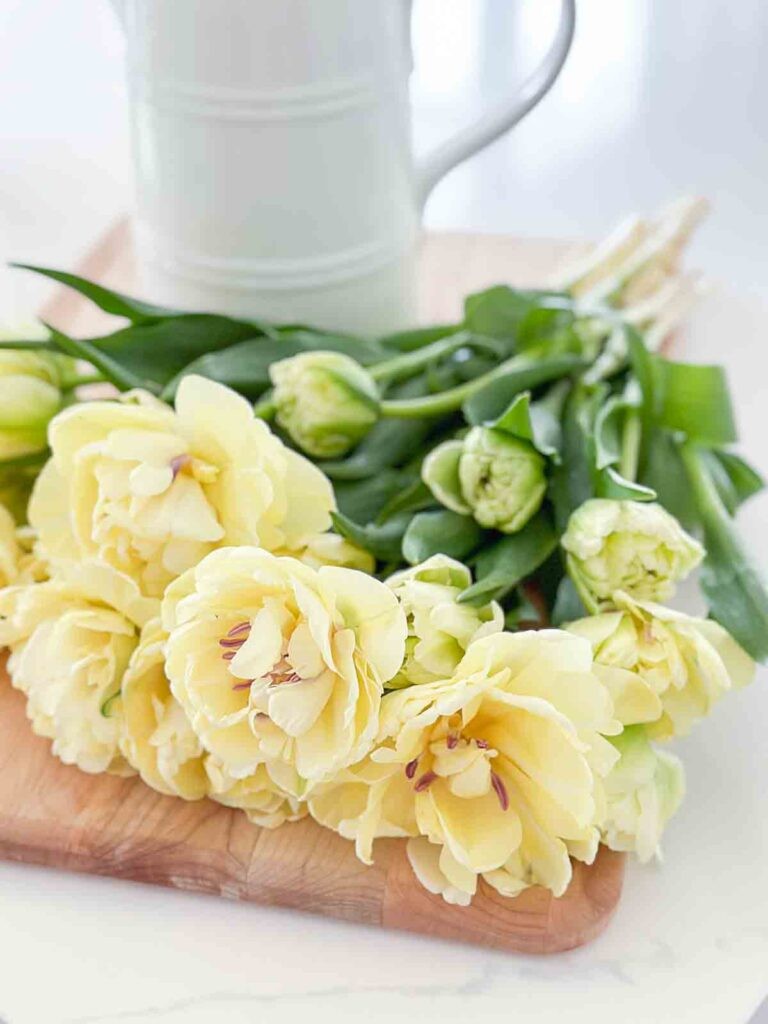
FAQs About Tulips
Here are some frequently asked questions about caring for tulips in a vase:
1. Why do my tulips droop?
Tulips droop because they are thirsty and quickly dehydrate. Rehydrate them as soon as you bring them home by cutting the stems at a 45-degree angle and plunging them in cool water up to their flowers for several hours or overnight.
2. Is drooping a normal part of the tulip’s life cycle?
Yes, drooping is a natural part of the tulip’s life cycle. Tulips continue to grow even when cut. Embrace the beauty and graceful drooping of these beautiful blooms.
3. How often should I change the water for my tulips?
Change the water daily or every other day to keep it fresh and free of bacteria. Each time you change the water, rinse the vase and recut the stems.
4. Does putting a penny in the vase really help?
Putting a penny in a vase of tulips may help extend their life and freshness. The copper in a penny acts as a fungicide. However, only pennies made before 1982 have enough copper in them to work.
5. Can I use flower food with tulips?
Yes, you can use flower food, but be cautious. Flower food usually contains sugar, which can promote bacteria, and tulips are especially susceptible to even small amounts of bacteria.
6. Why do tulips bend towards the light?
Tulips bend towards the light because they have a plant hormone that causes them to elongate on the side facing the light source. Rotating the vase regularly can help them grow more evenly.
7. Should I remove the leaves from the stems?
Yes, remove any leaves that will fall below the waterline in the vase to prevent bacterial growth.
8. How do I keep my tulips upright in a vase?
To keep tulips upright, ensure they are well-hydrated, use a supportive vase, and keep them in a cool location away from direct sunlight. You can also try wrapping them in newspaper overnight to help them regain firmness.
9. What’s the best way to cut tulip stems?
Cut the stems at a 45-degree angle using a sharp knife or floral scissors. This helps the tulips absorb water more efficiently.
10. Can I revive drooping tulips?
Yes, you can often revive drooping tulips by rehydrating them. Wrap the tulips tightly in newspaper and place them in cool water overnight. This can help them regain their firmness.
By following these tips, you can keep your cut tulips looking fresh and beautiful for longer, brightening up your space with their color, charm, and delicate beauty. At CARS.EDU.VN, we believe in providing you with valuable information that enhances your life, whether it’s about car care or flower care.
For more expert tips on maintaining beauty and functionality in all aspects of your life, visit CARS.EDU.VN. Our comprehensive guides and resources are designed to help you make informed decisions and enjoy the best possible experiences.
Are you facing challenges in finding reliable auto repair services or understanding routine maintenance? Do you feel overwhelmed when choosing the right car or dealing with minor car issues? At CARS.EDU.VN, we offer detailed guides and expert advice to address these concerns. Contact us at 456 Auto Drive, Anytown, CA 90210, United States or via Whatsapp at +1 555-123-4567. Visit our website cars.edu.vn for more information and discover how we can assist you today.
